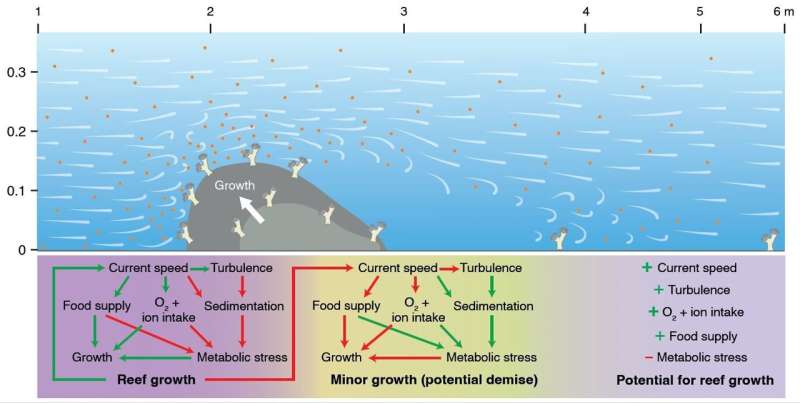Coral reefs are spatially distributed to maximize the availability of resources, finds reef formation study

Scientists from the Institut de Ciències del Mar (ICM), the Universitat de Barcelona, the National Oceanography Centre (NOC) and other European research centers have found that cold-water coral reefs—similar to those located in tropical areas but found at greater depths—are distributed in a specific way throughout space to maximize the availability of resources, acquired through capturing particles of organic matter that are transported by marine currents.
The details of this research are reported in a study published recently in the journal Scientific Reports, which has modeled the hydrodynamic factors that control the growth and morphological evolution of these reefs, considered hotspots of biodiversity in deep environments. This is a major breakthrough, since until now very little was known about the processes that induce the formation of the complex three-dimensional structures that characterize them.
To carry out the study, the authors designed a complex experiment by placing an artificial reef with live corals in a tank and exposing it for months to unidirectional currents, thus recreating the physical characteristics in which these reefs are found in deep sea environments.
Thanks to this, they were able to test a long-standing hypothesis: that corals grow towards the prevailing current. In this sense, the results of the experiment revealed that the colonies at the frontal part of the reef, and therefore more exposed to the currents, grew much more and showed a lower degree of stress.
In addition, the team observed greater growth in colonies located at some distance from the front of the reef, where the speed and direction of bottom currents are re-established and allow other reefs to develop. These patterns strengthen the idea that corals are able to self-organize in space to take better advantage of available resources.
“Our results show that the presence of a reef causes a deviation of the bottom currents above it, creating a shaded area at the back where the exchange of oxygen and ions involved in the calcification of corals decreases, and through which much of the food that is in suspension does not pass. This is reflected in the reduced growth and in the expression of stress-related proteins in the corals that inhabit these zones,” explains Guillem Corbera, the lead author of the study.
Claudio Lo Iacono, co-author of the study, points out that “we have been able to observe the growth of a reef by studying the processes of interaction between its morphology and the surrounding hydrodynamics, which even affect the physiological processes of the colonies themselves. Therefore, we believe that these bio-constructions can self-organize in space and time.”
Knowledge about cold-water coral reefs is important because of their uniqueness and key role in the ocean, where they act as architects of deep ecosystems and serve as refuges for many species. In addition, the analysis of their chemical composition provides insight into their past climate, as this depends mainly on climatic oscillations associated with ice ages, changes in sea surface productivity and sea level variations.
More information:
Guillem Corbera et al, Local-scale feedbacks influencing cold-water coral growth and subsequent reef formation, Scientific Reports (2022). DOI: 10.1038/s41598-022-24711-7
Provided by
Institut de Ciències del Mar
Citation:
Coral reefs are spatially distributed to maximize the availability of resources, finds reef formation study (2022, December 21)
retrieved 21 December 2022
from https://phys.org/news/2022-12-coral-reefs-spatially-maximize-availability.html
This document is subject to copyright. Apart from any fair dealing for the purpose of private study or research, no
part may be reproduced without the written permission. The content is provided for information purposes only.
For all the latest Science News Click Here
For the latest news and updates, follow us on Google News.

